A picture book story of how I found a niche in the world of radio controlled aircraft that I wanted to be a part of so badly that I created my own online gig to fund it. At 13 years old, I was custom building and selling unmanned aircraft electronic systems, starting from nothing but a soldering station and an Internet connection to RC forums.
Contents
Foundations
Learning and Research
Business: The first few years
Confidence and Complexity
Personal Builds
Takeaways
 Me in my workshop, sometime around 2015, building ready-to-fly wireless video systems for model aircraft.
Me in my workshop, sometime around 2015, building ready-to-fly wireless video systems for model aircraft.
The Beginning: RC Cars & Science Fair 2011
I was into RC cars since I was really young, probably 7 or so, and became fairly obsessive over them as I got my hands on more “hobby grade” stuff like Turnigy and Traxxas. Luckily for me, my parents recognized my interest and I scored some cool stuff at Christmas and my birthday.
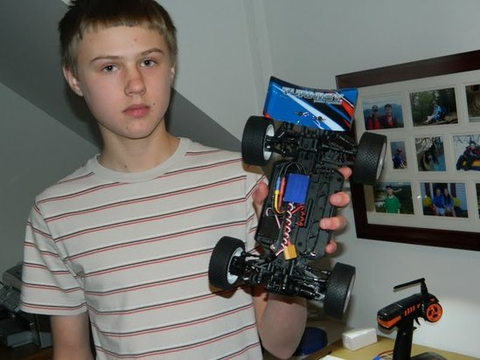
Around 2010, I started to use forums and the internet to research RC, and found myself amazed at FPV flying. First Person View (FPV) Piloting, the hobby of adding wireless video cameras to model airplanes was around for many years, but it had not reached the level of commercialization that quadcopters brought in many years later. Miniquads were not even a niche back in 2011 from what I remember… the tech was still too bulky and finicky to work on smaller platforms. HobbyKing KK2.0 boards were in full swing and tricopters were the cool thing to do if you were a DIYer. GoPros came out at some point and changed the FPV footage quality on YouTube immediately.
I was fascinated most by the longer range flights over the alps and other mountainous regions that would never be feasible without RC aircraft (Trappy’s narrow flights through mountain passes in the Formation Proximity videos would be chaos even for modern wingsuit daredevils).
Starting out in my research, there was a feeling of mystery surrounding all the tech, with people custom building and hacking all these security cameras and video components. There was also the freedom of the skies - it was a totally unregulated hobby. With UHF control systems like Thomas Scherrer and, eventually, DragonLink, hobbyists stopped boosting their 2.4 GHz control signals and with the range of 433 MHz they were able to fly into the clouds.
I was desperate to get my hands on this technology and cloud surf too!

I asked my parents to buy me an RC jet for a science fair project on UAVs as a display item for the presentation of this project. I got a SkyFun jet from HobbyKing and an old 72mhz radio control that I got cheap (free? I forget) on the RC forums. Not knowing what I was doing, I promptly tried to fly it and crashed, even before the science fair itself. I repaired it and still displayed it on the table with my giant poster board above.
At one point in time, this poster board picture with me in it was featured on TBS’s website, because I asked Trappy for help in designing the layout of the electronics for the plane in my project. Later on in life, I used this poster board to create a shipping box large enough for a RMRC Penguin aircraft frame after I was done flying it and had moved on to other projects.
That was my entry into the world of aerial RC: a crashed EPO science fair jet that had no business being in a beginner’s hands. Luckily, Christmas was right around the corner, and I had a chance to redeem myself and not be an idiot and buy a trainer style aircraft.
Learning and Research: 2012
My parents recognized my interest in flying and agreed to buy me a foam “Tuff Trainer” from HobbyKing for Christmas of 2011, and I promptly learned the ropes of flying RC airplanes with it. Looking back, I am thankful that they engaged with my hobby interests.
I expertly avoided the woman walking and my brother with the camera somehow, but still landed into a fence. A+

I obviously had no money at 13 years old to buy any drone technology, but I researched as much as I could. I poured over online forum boards like RCGroups ad FPVLab to understand the technology and see the custom modifications and soldering work that others were doing. I learned the common mistakes as well which was even more important: folks firing up their vTX’s without antennas and frying them, interference between radio or electronics systems, lack of filtering, forgetting simple DIP pin configurations to sync frequencies, and more.
This was during the time of YouTubers like Team Blacksheep, muni86, and Crashz9, who were all pioneers of the world of FPV (First Person View) radio control piloting on YouTube. TBS was of course, popular for his flight over New York City, which blew up the RC Internet space for some time about the dangers associated with FPV flying.
FPV in 2012 was hacking, soldering, and custom wiring looms everywhere. There was no DJI Phantom to fly, and very little (read: zero) ready-to-fly FPV aircraft. As I read RCGroups and FPVLab on a daily basis, I started to realize that there was a significant market for this sort of electronics setup service in the FPV hobby. If you knew what parts to buy and how to wire the stuff, it was a breeze. But with many folks still getting used to touch screen phones, this was a significant challenge.
And thus, the idea was born: I can learn how to set these wireless video link systems up for RC aircraft and sell them! Logistically, PayPal existed back then, albeit still a little bit in its infancy (read: not as regulated), so I was able to accept payments from people all over the country and world without doing sketchy “money orders” through the mail or something. I had some basic electronics equipment like a soldering station, so I didn’t need to buy any special tools right off the bat.
I got my Amateur Radio License around this time just to be legal when using the frequencies that FPV pilots were using. I learned more about electronics and radio through this. I was just old enough to get the license, and thanks to my parents for paying the study and exam fees, I passed the technician’s exam and received my callsign.
Business Begins: 2013 - 2014
I was able to successfully post ads to R/C forums to advertise my electronics wiring and wireless video system set-up service. I had an edge in that I had thousands of posts on some of these forums, so I was already a “respected” community member. I also had all sorts of pictures on there of different planes I flew and stuff I had soldered, etc, so there was already some sense of a “work portfolio” that proved I wasn’t an idiot.
I made a couple hundred dollars my first few years, but this was basically like being a millionaire for my age. Here are some of the setups that I was building - simple, neatly integrated components: cameras, transmitter / receiver combinations, antennas and video monitors, all with the right battery plugs, filters, and adapters to make it ready to go for the customer. A few customers just requested custom wiring looms, for example, just for an OSD that would integrate with their entire aircraft quicker than having to solder all the extensions and plugs themselves.
Basic Wireless Video Systems for FPV
These setups were customized to what the pilot wanted, but most included these components. Some opted to use a separate battery for their video system, whereas others “tapped” the main aircraft battery pack either at the ESC connection or using the balance port. This was an easy option for 3S LiPo powered airplanes because they could power 12v video systems.
- 900Mhz or 1.3 GHz Video Transmitter & Receiver
- Notch Filter on vTX to decrease interference on 2.4 GHz control bands
- Set of circularly polarized antennas for best all-around performance flying around ground station
- Inline “tap” adapter for 3S LiPo main aircraft battery power to video system
- Filtering on power input side too on vTX to eliminate lines in video
- 550TVL to 700TVL NTSC security camera, or sometimes a GoPro plug to get the live feed from that instead
- Phillips 9’’ monitor or RMRC 9’’, sometimes 12’’ or other variations
This is a classic, simple, tried-and-true system which I built on many different video frequencies for either GoPro live feeds, or a stand alone FPV (normally a small 1/3’’ CCD security type) camera. These were popular systems due to simplicity and low cost - just plug the tap adapter between the ESC & battery of your aircraft, mount the vTX, and hook up a 3S to the RX with the monitor on a tripod, and you are ready to go. The main worry was not to fly out of range of your 2.4 GHz stock radio controller (in those days, about a half mile was safe).

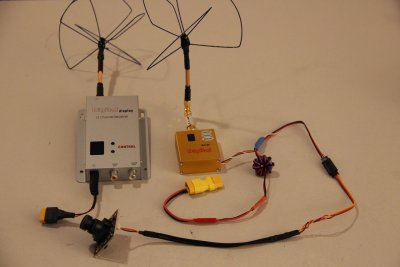
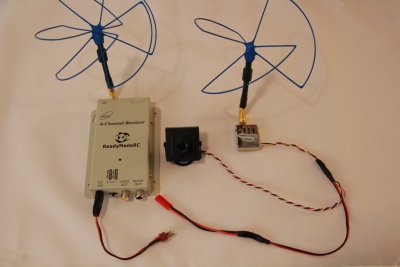
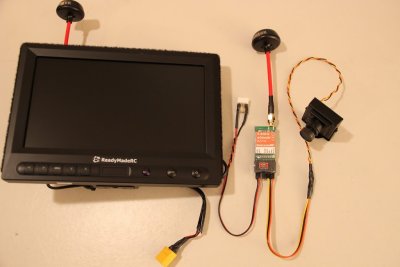
Longer Range with On-Screen-Display (OSD) Example
Folks who wanted to fly longer range needed patch antennas and on screen displays (OSDs) that could relay important information on the edges of the video feed including battery voltage, current, and even an arrow to point them back home if they become disorientated. Back then, EzOSD, EagleTree Vector, and CYCLOPS NOVA were the top systems that I remember.
- 2.4 GHz 500mw LawMate Transmitter & Receiver
- 2.4 GHz Patch Antenna (8dbi)
- ImmersionRC EzOSD
- Voltage regulator (12v to 5v) from amp sensor on EzOSD to power LawMate vTX
- RMRC 700TVL FPV Camera (12v)
This system was tricky because of the LawMate vTX running 5v and camera on 12v. The EzOSD was a breeze to set up though, and some of the features it has far outweighed the price during the time period - speed, distance, altitude, direction to fly back to yourself, and of course power details and other features. With a 500mw 2.4 GHz connection and this patch antenna, I’ve seen pilots fly out 10 miles and back (give or take) without a glitch. The LawMate brand fell out of style shortly after ImmersionRC, ReadyMadeRC, and HobbyWireless (and GetFPV, later) came onto the FPV scene and marketed their products efficiently to the FPV hobbyist crowd.
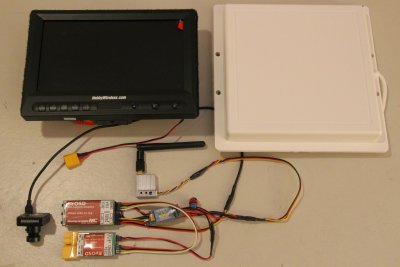
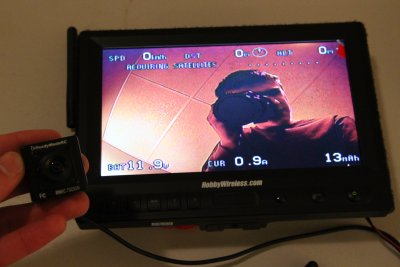
I was proud of my work, taking the time to put extra heat shrink and make the wiring as neat as possible. I personally would have high expectations when buying any custom electronic system that is going up in the air!
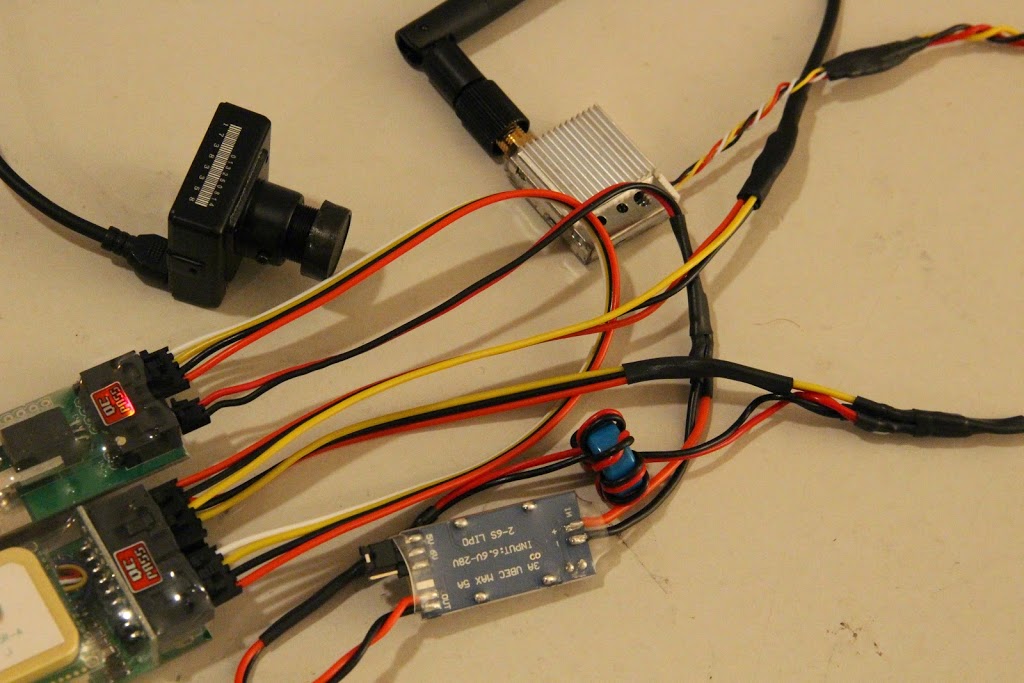
Confidence and Complexity: 2015 - 2016
In these years I became more confident and built more complex systems, for customers and personal use alike, before putting this amazing hobby of mine on hold to leave for university. I built larger systems for many folks mostly in USA but also UK and NZ and sometimes others. Some systems I offered to put in Pelican cases like the one below. Others were simply extensions of the basic systems I built before, but on different frequencies, with different components, or for different purposes. One interesting customer I had wanted a live video feed from the inside of his full-scale race car.
Something that became more popular in the FPV world was the idea of “repeating” the signal off of a main ground stantion to a pair of wireless goggles. This was unique because the ground station could be set up with a patch antenna for long range on, say, 1.3 GHz, and that 1.3 GHz receiver would be connected directly to a 5.8 GHz transmitter. The goggles could receive the 5.8 GHz signal, and thus you could launch and walk around nearby the ground station without having to be tethered to it. Of course, it added a point of failure, but most of these systems had a monitor or DVR to view the video feed just in case.
At this point, I was confident and started taking more risks financially too. I did pre-built setups, so that customers could buy a ready made system without having to really talk to me at all - it came with everything you needed minus the airplane to put it on. I set up those systems on 5.8 GHz and made good money on eBay and the forums. The parts would cost me around $130, and I could sell for $200 or more. I remember building 10 of those back to back (see pic of my workshop at the beginning - those boxes stacked up are all completed products), and burnt myself out.
The workload and income was perfect. On a good summer flying season I would have 2-5 setups per month, and pull in something like 100-300 bucks. This business could never scale, but it’s really all I needed to buy more R/C and FPV gear and keep working on my own projects simultaneously. At this point the post office was getting better at doing consistent 3-day shipping, so I’d tell customers the time to receive their order was broken apart like:
- Day of payment: I order the necessary components online
- add 3 days for me to get the parts
- add 1 day to build and test then drop it off the next morning at the post office (mom also gets credit here because she would do this while I was in school when she ran errands - thanks mom!)
- add 3 more days as the package made it out to them
So, for customers in the USA, the whole service took roughly 1 week from the time of payment to the time the customer received the built system. For a one-man shop, I was proud of that turn around!
This was the time when I set up a website for myself using Wix, and attracted more expensive requests. Honestly, I knew the end was near, as RMRC and GetFPV and all these places started popping up who offered complete systems. Plus, the commercialization of the hobby was just at the cusp of taking off with ready-to-fly quadcopters with live video feeds.

Encased Repeater Ground Station Example
- 1.3 GHz Transmitter/Receiver (with ComTech tuner)
- 1.3 GHz 8dbi Patch antenna in case top, linear whip antenna on vTX
- CYCLOPS On Screen Display
- Headtracking pan and tilt setup with accelerometers in goggles and 2 servos on camera mount
- 5.8 GHz ImmersionRC vTX in the case (top of 1.3 RX) to repeat signal for goggles
- RMRC 700TVL FPV Camera, mounted onto pan and tilt mechanism
- FatShark Dominator Goggles w/built-in 5.8 GHz module (WIRELESS long range due to repeater!)
- Backup/spectator 7’’ monitor
- 3S LiPos, independent from aircraft power system due to high voltage aircraft setup
- Also made a custom wiring schematic for this one due to complexity
- DragonLink UHF system for aircraft control also set up - not pictured - ready for head tracking
Case setups in general were always my favorite simply because I’m a very neat and organized person who likes things nicely put together and ready to operate as they are stored. This case had everything needed - and even repeated the signal over to a pair of wireless video goggles, so the pilot could walk around while flying, or even just taking off, without having to deal with wires going to his or her head.
This pilot requested it all - from an On Screen Display, to Return to Home functionality, to head tracking and even a DragonLink UHF system so he/she could fly out long distances without worrying about the radio control link. There was also a backup 7’’ display monitor built into the case so that if the battery on the goggles’ end died, you could swiftly run over to the case and pilot from the monitor built in (with the design that the sun would be blocked by the cover, which would be propped up by a small rod to aim it towards the general direction of flight). Also, spectators could take a gander at what was going on while the pilot was focused in his/her goggles.
The CYCLOPS Tornado OSD is an incredibly powerful device - as you can see in the 3rd picture where I am holding the monitor, this OSD had it all, including the heading spot in the middle and bars on the right, left, and top to aid in maintaining level flight for long periods of time (or watching how fast you’re descending//ascending). With the box being powered by a giant 8,000 mAH 3S LiPo, this case was good for multiple hours of operation. I also specifically chose a lower power output 5.8 GHz repeater transmitter so that it would not burn out without as much airflow as one could expect on an aircraft.
All said and done, I was jealous when I shipped this system out, and am extraordinarily proud of the end result. The pilot loved it as well!
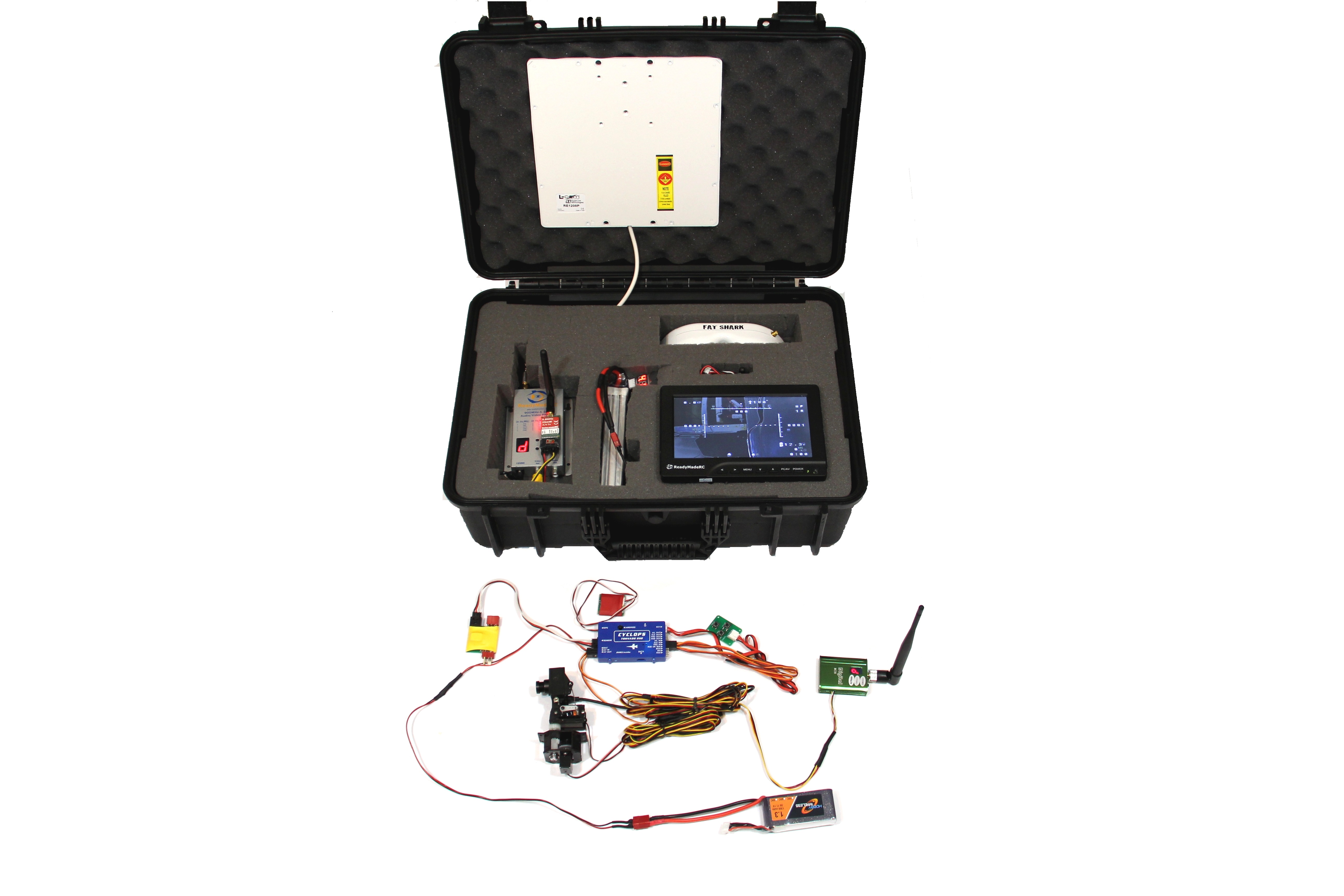
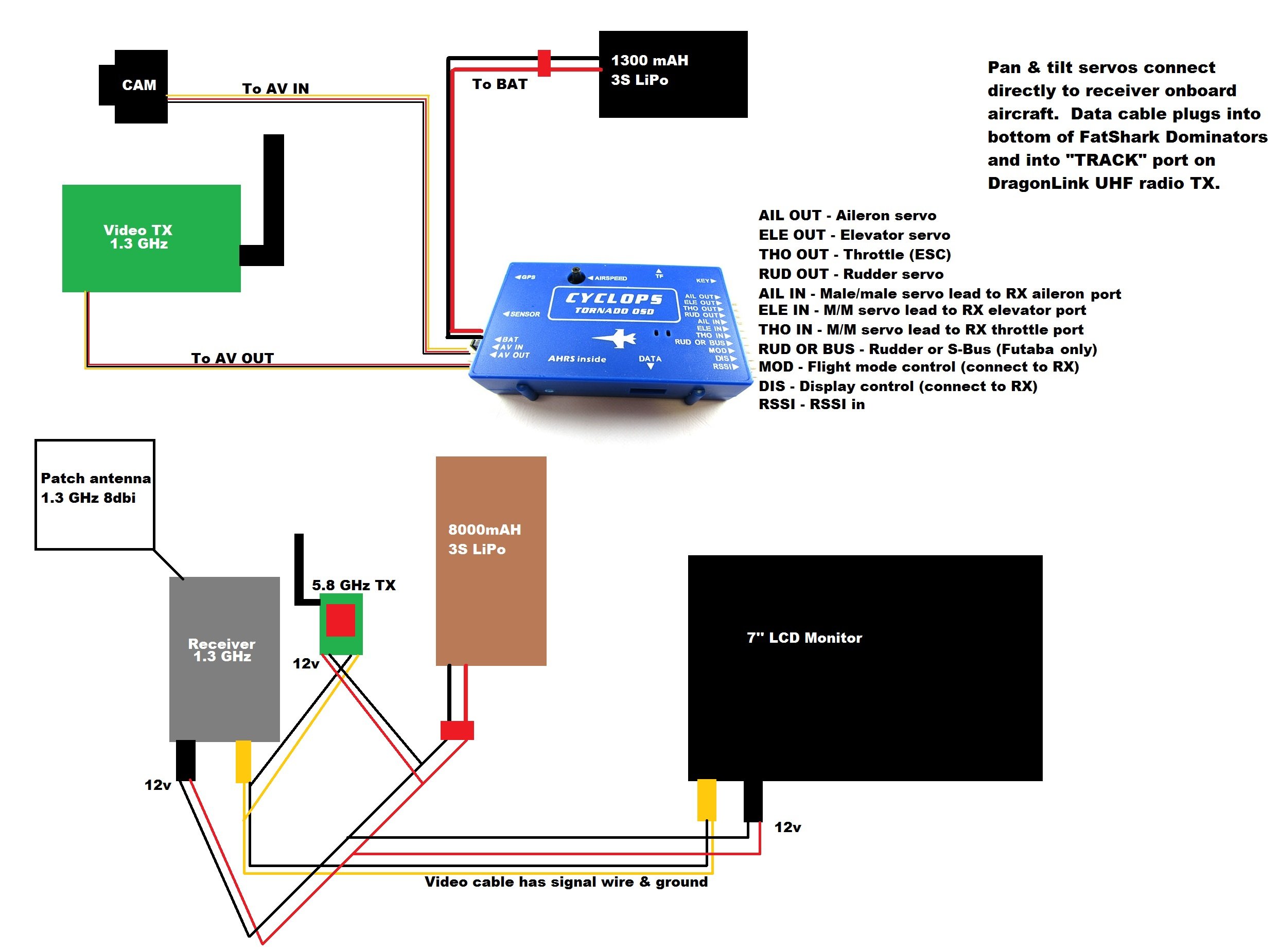
Here is a pic before encasing the system:
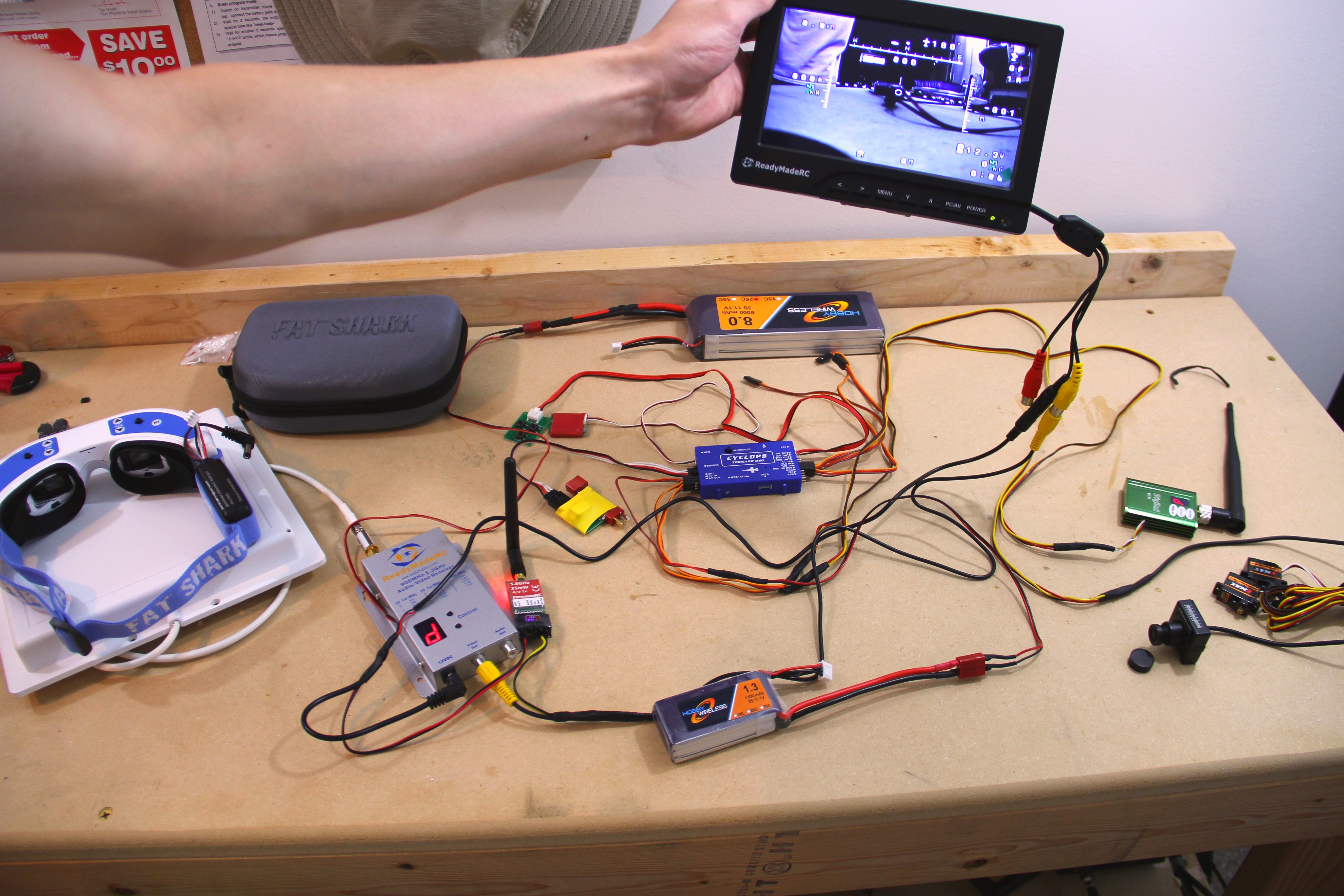
I built other case systems similar to this. It was something I built later on in life for myself too - this way you just show up to the field and there’s no tripod with wires all hanging off it it ready to be a liability. Open up the case, plug it in, aim the antenna, and fly.
Diversity Repeater System with Recording DVR of Live Feed
Another repeater system, this time using diversity to maintain signal connection in different flying situations. A digital video recorder (DVR) is integrated to help with recovery of a downed plane, and just for recording in general.
- Two 1.3 GHz Video Receivers
- Stock whip antenna on one, Video Aerial Systems antenna on the other
- All mounted on back of VAS antenna
- Eagle Eyes diversity system
- DVR also wired in to record live feed from aircraft
- 25mw 5.8 GHz vTX to repeat signal to video glasses
Diversity is a useful function if the pilot desires to fly out long distances in one direction, but also for example, wants to take off in the opposite direction so he would be flying BEHIND a patch antenna and then out front for the duration of the mission. The EagleEyes unit takes two inputs for receiving the video signal and chooses which one is strongest. Another valid option is antenna tracking, which automatically points the antenna towards the aircraft while it’s flying, but those systems are few and far in between, and generally antiquated now with diversity and circularly polarized antennas making a huge mark in the market.
I actually messed up on this one. I didn’t build the backside to match the orientation of the sticker on the front of the antenna, so it was upside-down! And I couldn’t get it off - it was like a full sized thing that wrapped the entire front. Luckily, these antennas can be upside down without any side effects, and the customer was not worried about it.
These systems were complex, but they were nothing ridiculous. Video ins and outs, 12v power, antenna mounting. The real challenge of some of this was to understand which components were going to interfere with others due to harmonics or just poor engineering - and buy the appropriate filters, like low pass or high pass filters and others. Some ESCs (electronic speed controllers for the airplane motor) were “dirtier” and caused lots of noise in the video signal if powered by the same battery. LC filters solved this, and knowing about that beforehand was part of the service that I was selling.
My Personal Setups
Remind me why I even started all of this? Oh, to get into FPV myself!
Over the years, I built many setups for myself - here are just a few that I am proud of that I set up on different frequencies for different purposes. After all, the purpose of having the business was to buy more stuff that I could fly myself. :) I did build a few multirotors (a hexacopter, a few quads), but preferred fixed-wing.
Long-Range Finwing Penguin
This easily flew out a few miles and back over the country, and also did some altitude flights. Here’s me on the sticks testing flying LOS (line of sight) with my Taranis hooked to DragonLink & SR771 antenna. 400mw on 1.3 GHz can really push a number of miles with a patch antenna on the RX. One of the tricks of the hobby to get more range was to upgrade the antennas instead of buying higher output transmitters, because increasing power output on the vTX tended to cause interference with other components onboard, when you could easily get better range by just using a patch antenna or a yagi if you really needed it.
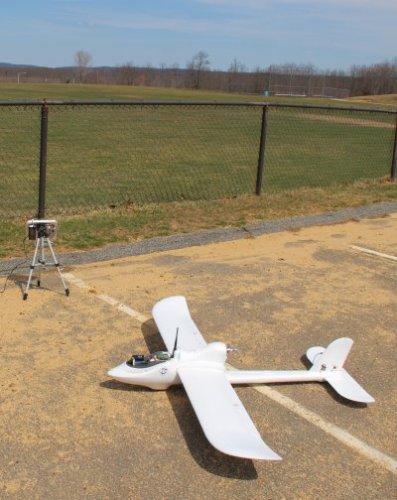

I loved this setup for the sheer freedom I got in the air - with 30+ minutes of flight time and insane range, I could just float around and enjoy it. However, the size of this plane got annoying to transport over time. It was great that I could take off from the ground instead of hand-launching, but taking the wings apart was a pain.
Flying Wings of all shapes and sizes …
The yellow one is a Wicked Wing conversion from a slope soarer to powered. I used 2.3 GHz because it had just been approved by the FCC due to RMRC’s diligence helping the FPV community, and I wanted to see how well it performed. The thinner wing ran 910 MHz, it was a Crash Test Hobby Titan. These flying wings were a lot of fun, and the durability was a huge plus.

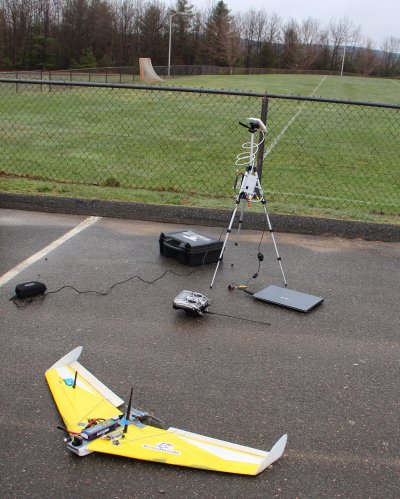
Takeaways
Entrepreneurship is difficult, but with the right niche I made it work while I was in high school to fund this hobby I loved so much. As I began to wrap up my operations and shut down shop to go off to college, I saw this sort of service was less and less in demand as the DJI Phantom and other ready-to-fly quadcopters were on the market.
After a certain point, the folks who needed my service moved to off-the-shelf RTF quads, and those who stayed with planes didn’t need my services anymore - the knowledge was much less hidden deep in the forums to build the stuff yourself. My niche service had its day, and then ended.
I find this whole entrepreneurship situation to be a good example of “modest success”. I had no need to scale this to infinity, I had no bandwidth to get more than one or two setups per week as it was, and even that was a bit too busy sometimes with school and other priorities. This little business was my hobby and I enjoyed it. In some sense, I am glad that I left it to go to college instead of try to make it a full-time thing, because I left it at a good stage where I was content with my work and where I had gotten. And honestly, building these things full time would get old.
I never thought of it as “a grind” or any sort of real “hustle”. It was just what I was interested in tinkering with.
Special thanks, of course, to my parents for not only buying me my first RC airplane(s), but also driving me around to fields to go fly, dropping off packages, and everything else.
My setups are almost antiquated at this point!
I will document in another entry some of my long range flights after I left college and got back into FPV. By the time I re-entered the hobby, much of the tech I knew was essentially outdated. Nowadays hobbyists would call my setups “analog” (!) because there are cheap digital live video transmission options now in the FPV world, which was unthinkable when I first started.
